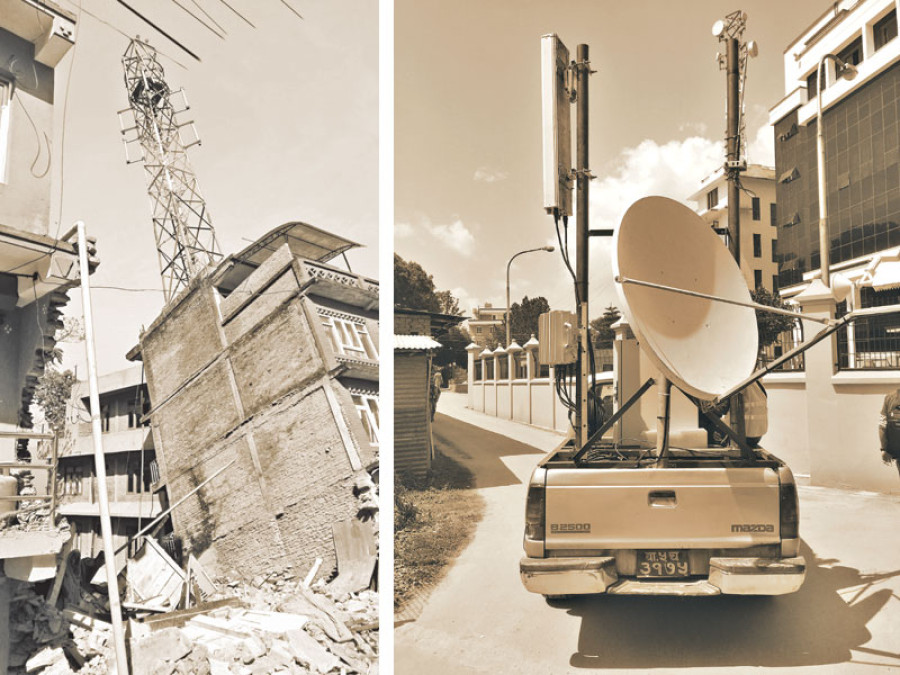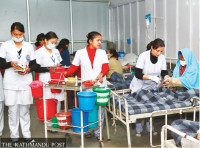Miscellaneous
Thank god for the phones
Telecom service providers bravely kept Nepalis connected during and after the devastating earthquake
Bibek Subedi
When the ground began shaking just before noon on April 25 last year, and houses started tumbling down all over, the first thing people did after recovering their composure was that they tried to call everybody they knew. And to their some relief, the phones were working, something they hadn’t expected standing amid the devastation casued by the 7.8 magnitude tremor.
There was widespread fear that telecom services would be hit hard by the quake, given the less than average quality service of Nepali telecom companies. “I thought it was the end of my life,” said Manish Bikram Shah of Dilli Bazaar, recounting his experience that fateful Saturday. Once the shaking stopped, he started fearing for the safety of his mother who was all alone at home. “I tried calling her 40 to 50 times before I got an SMS from her saying that she was safe and asking me about my well being,” he said. Like Shah said, phone calls didn’t get through at the first for many, neither did SMSs, but telecommunication services remained largely intact throughout the country.
GSM Association (GSMA), a representative organisation of nearly 800 operators with more than 250 companies in its report titled ‘Nepal Earthquake Response and Recovery Overview’ had said that 2G sites were down by 16.75 percent where as 3G sites were down by 23.23 percent right after the April 25 earthquake.
The availability of cellular phone services and nonstop internet came as much-needed relief to a large number of people after the April earthquake. The Nepali diaspora was also able to connect with their loved ones in Nepal through landline and mobile phones.
Nepal’s major telecommunication service providers—state-owned Nepal Telecom (NT) and privately-owned Ncell—both deserve an applause for providing continuous telecommunications services which helped people to communicate, learn the whereabouts of their family and friends, reorganise and, most importantly, give each other assurances that they were fine.
“The way our service providers managed to keep their networks functioning during the disaster was a praiseworthy job,” said Purushottam Khanal, director Nepal Telecommunication Authority (NTA).
According to the GSMA report, the mobile network infrastructure faced limited damage from the earthquake itself, rather, a combination of interrupted power supply, human capacity limitations and process challenges contributed to failures across the chain where they occurred.
In first few days of the earthquake, telecom companies did struggle to provide full-fledged services as base stations were affected. According to the GSMA report, significant numbers of base stations began to go down 48 hours following the earthquake; (300 down out of 500 in Kathmandu for NTC). Likewise, Ncell’s 220 sites were initially offline after the first earthquake. However, after the first 24 hours elapsed, this rose to 600+ due to the exhaustion of back-up power supplies, the failure of the grid and the lack of diesel/transport and access. “Commercial power was disrupted both because of damage to power infrastructure and also due to power companies switching off power to reduce danger of fire or injury caused by downed power lines,” states the report.
Both telecom companies deployed recovery teams to affected regions to restore the service. Teliasonera, the then owner of Ncell even sent a plane with supplies and experts to support recovery effort. Telecom operators opted for innovation, deploying makeshift Cells On Wheels which are essentially pickup trucks loaded with active cell equipment, to areas where rescue workers were based and displaced people were gathered.
Additionally, telecom companies also provided free top-ups and SMSs to their subscribers to help facilitate communication. Ncell added Rs 20 credit and 50 free SMSs to subscribers’ accounts while Nepal Telecom offered free SMS, data, and voice services for six days.
Buddhi Prasad Acharya, managing director of NT, said that the dedication of their personnel was key in providing uninterrupted service immediately after the earthquake. “Our service was interrupted briefly, but our technical staff were able to fix the problem in no time and restore service,” said Acharya. “Our dedicated administrative and technical teams were on 24-hour duty despite the series of strong aftershocks following the earthquake.”
NT officials say that the technology used by the state-owned company was strong enough to withstand the tremors. “Around 98 percent of NT’s base transceiver station (BTS) towers remained intact because we had made sure that the buildings selected for erecting them were strong against earthquakes of even a high magnitude,” added Acharya. “This was part of our disaster preparedness.” BTS towers receive and transmit radio signals that connect cell phones.
Like the BTS towers, NT’s optical fibre network also kept working. Acharya said that the optical fibre network had been installed in a scientific manner to be able to resist major earthquakes.
Likewise, private operator Ncell provided impressive services during the critical period following the massive earthquake. “As we operate in an earthquake-prone zone, we had been giving high priority to disaster preparedness since 2012. Such preparedness enabled us to provide quality services to our client during the earthquake,” said Milan Mani Sharma, corporate communication expert at Ncell. “We had quick deployment units as part of our preparedness plan, and we mobilised them to repair the BTS towers that were damaged during the quake.”
According to Sharma, Ncell also identified places where new networks were required, especially in locations where a large number of quake survivors had taken refuge, and deployed its units to extend services there.
He added that Ncell had multiple data centres connected to each other at different locations allowing them to switch from one to the other in case of emergencies. Ncell maintains data centres in Kathmandu, Pokhara, Hetauda and Biratnagar. The data centres in Pokhara and Hetauda are containerized so they can survive high-magnitude earthquakes, according to Sharma.
“We can resume services within an hour if there is any kind of interruption following a natural disaster,” said Sharma.
Way forward
One year after the devastating earthquake, both NT and Ncell insist that they had come a long way in disaster preparedness. NT is planning to build data centres in multiple locations outside the Kathmandu Valley. The state-owned company is considering Hetauda and Bhairahawa as possible locations for its data centres. “We want to make sure that all our equipment are housed in secure buildings,” said Acharya. “So we will be constructing a building that can withstand earthquakes of 10 Richter scale.”
As Ncell already has data centres in multiple locations, it is planning to expand its containerized data centres to other locations. Similarly, they are strengthening their quick deployment units.
“Moreover, we are continuously making our customers aware as part of our preparedness plan,” said Sharma. “During disasters, everyone wants to get connected with their loved ones resulting in network congestion. So, instead of trying to call, one should send an SMS.”
Even then, cellular network congestion is seen whenever an aftershock of a large magnitude hits the country. Educating customers with awareness plans continuously will improve the situation, and Ncell frequently conducts such campaigns for its customers, according to Sharma.
Regarding BTS towers, the NTA has asked telecom service providers to install lightweight towers on residential buildings so that they do not get pulled down by the weight of the tower during a major quake. Ncell claimed that all its new BTS towers were light in weight.




 8.12°C Kathmandu
8.12°C Kathmandu










